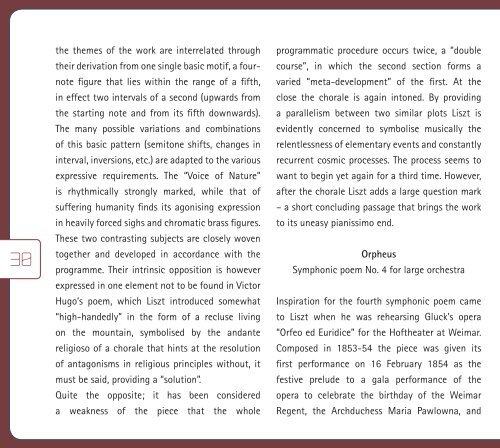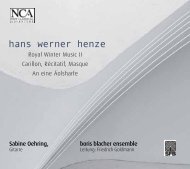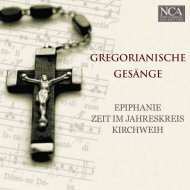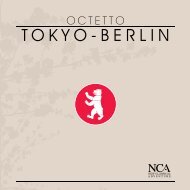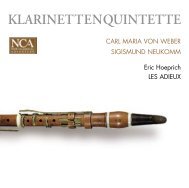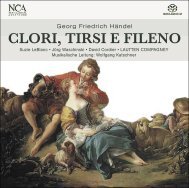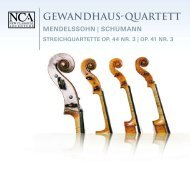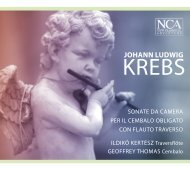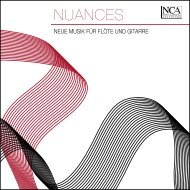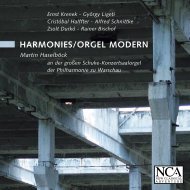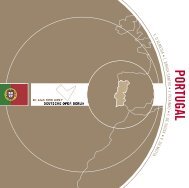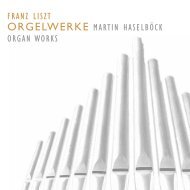FRANZ LISZT - nca - new classical adventure
FRANZ LISZT - nca - new classical adventure
FRANZ LISZT - nca - new classical adventure
Create successful ePaper yourself
Turn your PDF publications into a flip-book with our unique Google optimized e-Paper software.
the themes of the work are interrelated through<br />
their derivation from one single basic motif, a fournote<br />
figure that lies within the range of a fifth,<br />
in effect two intervals of a second (upwards from<br />
the starting note and from its fifth downwards).<br />
The many possible variations and combinations<br />
of this basic pattern (semitone shifts, changes in<br />
interval, inversions, etc.) are adapted to the various<br />
expressive requirements. The “Voice of Nature”<br />
is rhythmically strongly marked, while that of<br />
suffering humanity finds its agonising expression<br />
in heavily forced sighs and chromatic brass figures.<br />
These two contrasting subjects are closely woven<br />
programmatic procedure occurs twice, a “double<br />
course”, in which the second section forms a<br />
varied “meta-development” of the first. At the<br />
close the chorale is again intoned. By providing<br />
a parallelism between two similar plots Liszt is<br />
evidently concerned to symbolise musically the<br />
relentlessness of elementary events and constantly<br />
recurrent cosmic processes. The process seems to<br />
want to begin yet again for a third time. However,<br />
after the chorale Liszt adds a large question mark<br />
– a short concluding passage that brings the work<br />
to its uneasy pianissimo end.<br />
thereafter without any changes joined the series<br />
of symphonic poems as no. 4. As can be read in his<br />
programme foreword to this piece, Liszt’s intention<br />
was to represent in music the mythical character<br />
of the Greek singer and with him the myth of<br />
music itself, prior to the actual performance of the<br />
opera. Orpheus is depicted here as a symbol of the<br />
civilising and softening influence of music with no<br />
direct allusion at all to Gluck’s opera.<br />
“There was a reawakening of memories of an<br />
Etruscan vase in the Louvre, on which the first<br />
poet-musician is depicted with the mystical, royal<br />
circlet about his brow, draped in a cloak strewn<br />
“Orpheus” is one of Liszt’s most beautiful and<br />
poetic orchestral compositions, sublime in tone,<br />
great yet simple, and interwoven throughout with<br />
lyrical feeling. The myth of music brooks no hint of<br />
conflict within itself. In a letter to Alexander Ritter,<br />
a musician and composer belonging to Wagner’s<br />
family circle, Liszt pointed out “that ‘Orpheus’ has<br />
no actual development section and is quite simply<br />
suspended between pleasure and pain, expressing<br />
the reconciliation in art in a sigh of relief.” The<br />
structure of the work is simple, a large A-B-A<br />
form with few contrasts. After the introduction to<br />
sounds of the harp the main theme that represents<br />
together and developed in accordance with the<br />
with stars, his lips forming words of sacred songs,<br />
30 31<br />
programme. Their intrinsic opposition is however<br />
Orpheus<br />
Symphonic poem No. 4 for large orchestra<br />
and striking the lyre with a powerful motion of his<br />
Orpheus appears. A central section, in which a<br />
motif derived from the main subject is constantly<br />
expressed in one element not to be found in Victor<br />
Hugo’s poem, which Liszt introduced somewhat<br />
“high-handedly” in the form of a recluse living<br />
on the mountain, symbolised by the andante<br />
religioso of a chorale that hints at the resolution<br />
of antagonisms in religious principles without, it<br />
must be said, providing a “solution”.<br />
Quite the opposite; it has been considered<br />
a weakness of the piece that the whole<br />
Inspiration for the fourth symphonic poem came<br />
to Liszt when he was rehearsing Gluck’s opera<br />
“Orfeo ed Euridice” for the Hoftheater at Weimar.<br />
Composed in 1853-54 the piece was given its<br />
first performance on 16 February 1854 as the<br />
festive prelude to a gala performance of the<br />
opera to celebrate the birthday of the Weimar<br />
Regent, the Archduchess Maria Pawlowna, and<br />
finely formed fingers. The very rocks seem to listen<br />
and be moved, and from cold hearts flow a few<br />
burning tears.”<br />
This image seems to have been ever present during<br />
the composition, which is wholly governed by<br />
the sound of the harp. Through the use of harps<br />
in the score, a modern equivalent of the ancient<br />
instrument, Orpheus playing the lyre appears<br />
before the audience in a musical representation.<br />
spun out, leads to the triumphant recapitulation of<br />
the first subject. (It is quite possibly this technique<br />
of sustainably spinning out one motif over long<br />
stretches that so fascinated Wagner while working<br />
on the second act of his “Tristan” that led him<br />
to make special mention of “Orpheus” in a now<br />
famous letter referring to the symphonic poems.)<br />
Then follows the coda that belongs to the most<br />
puzzling of anything Liszt ever wrote. At first the<br />
english


